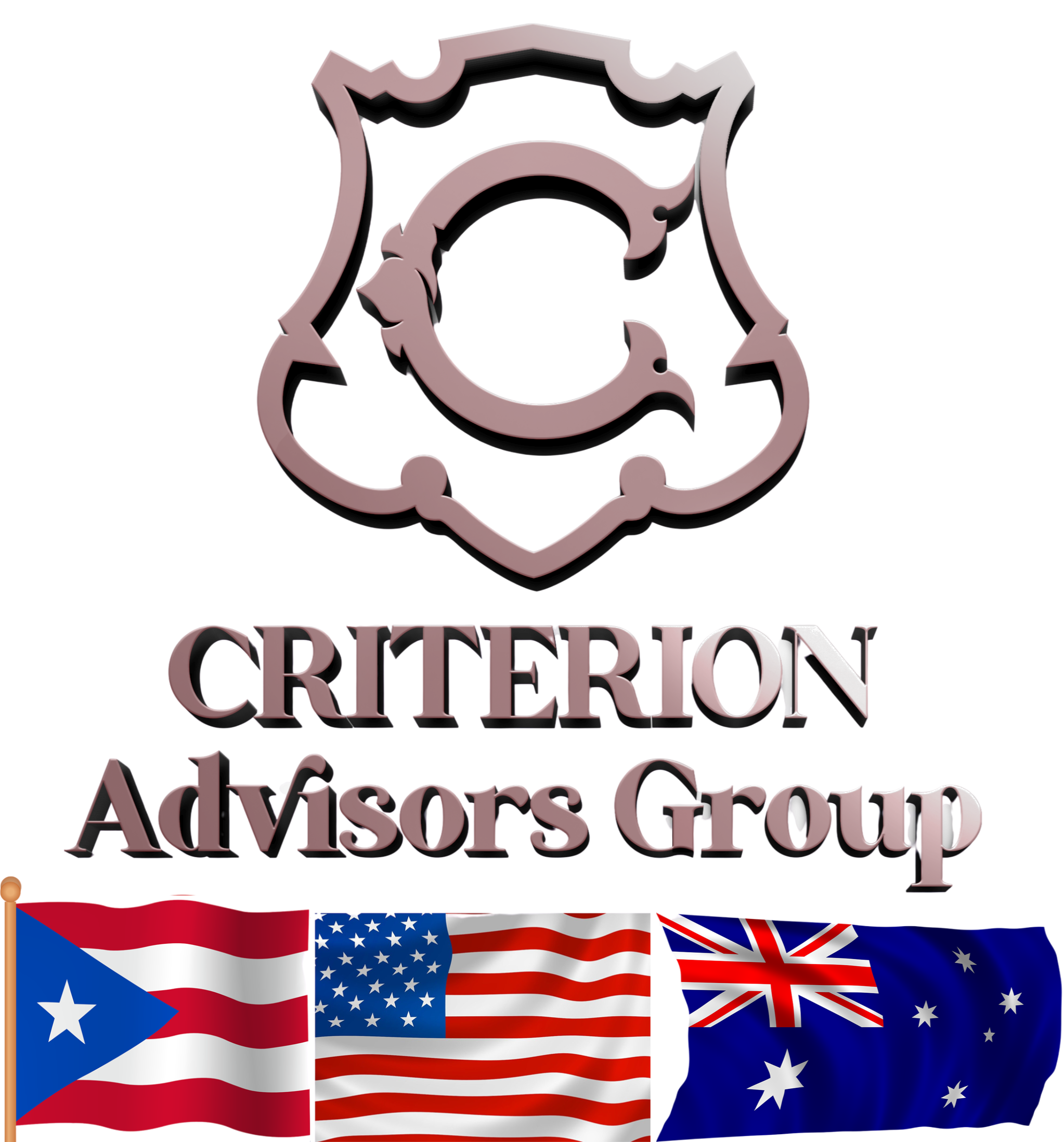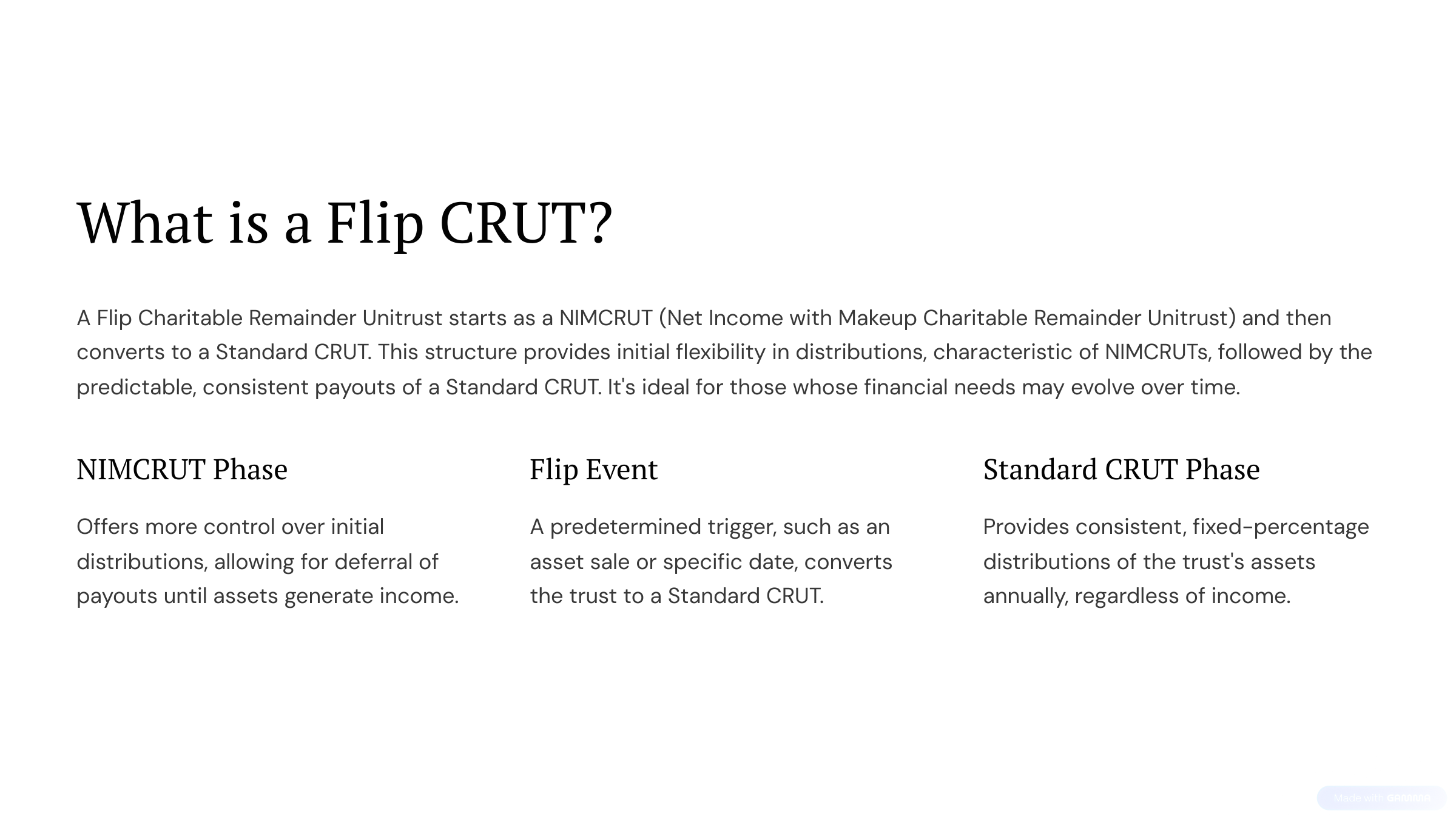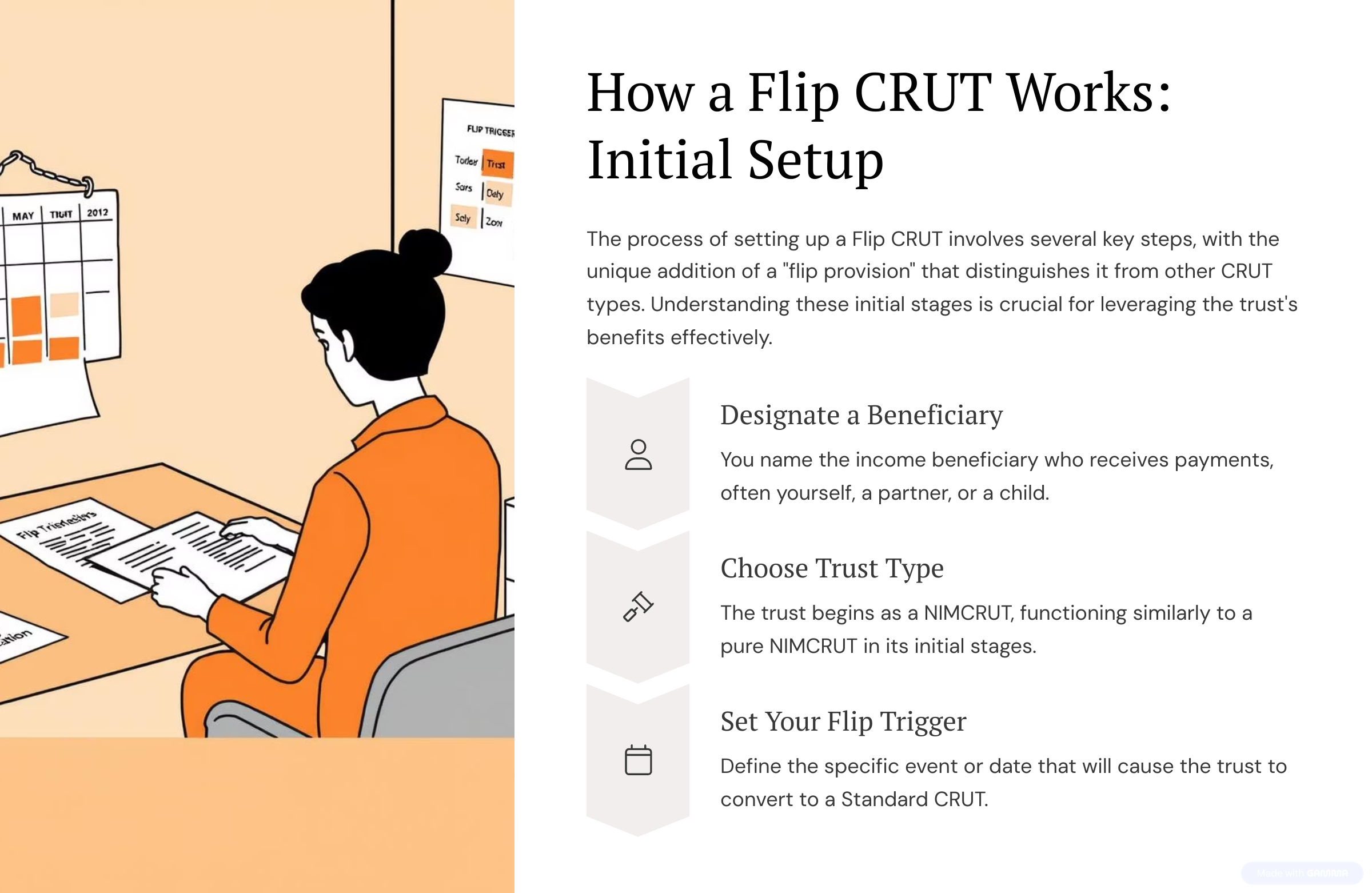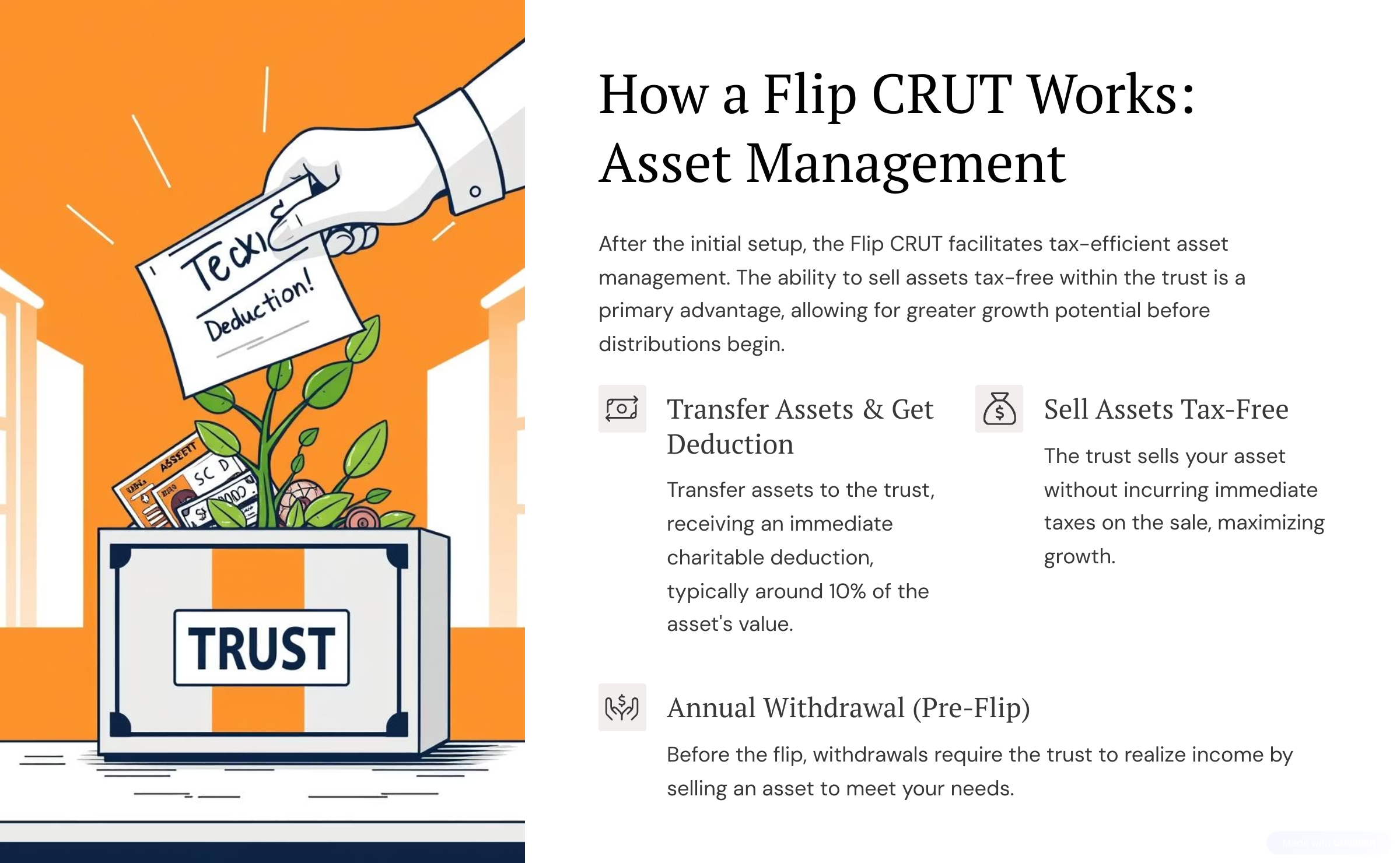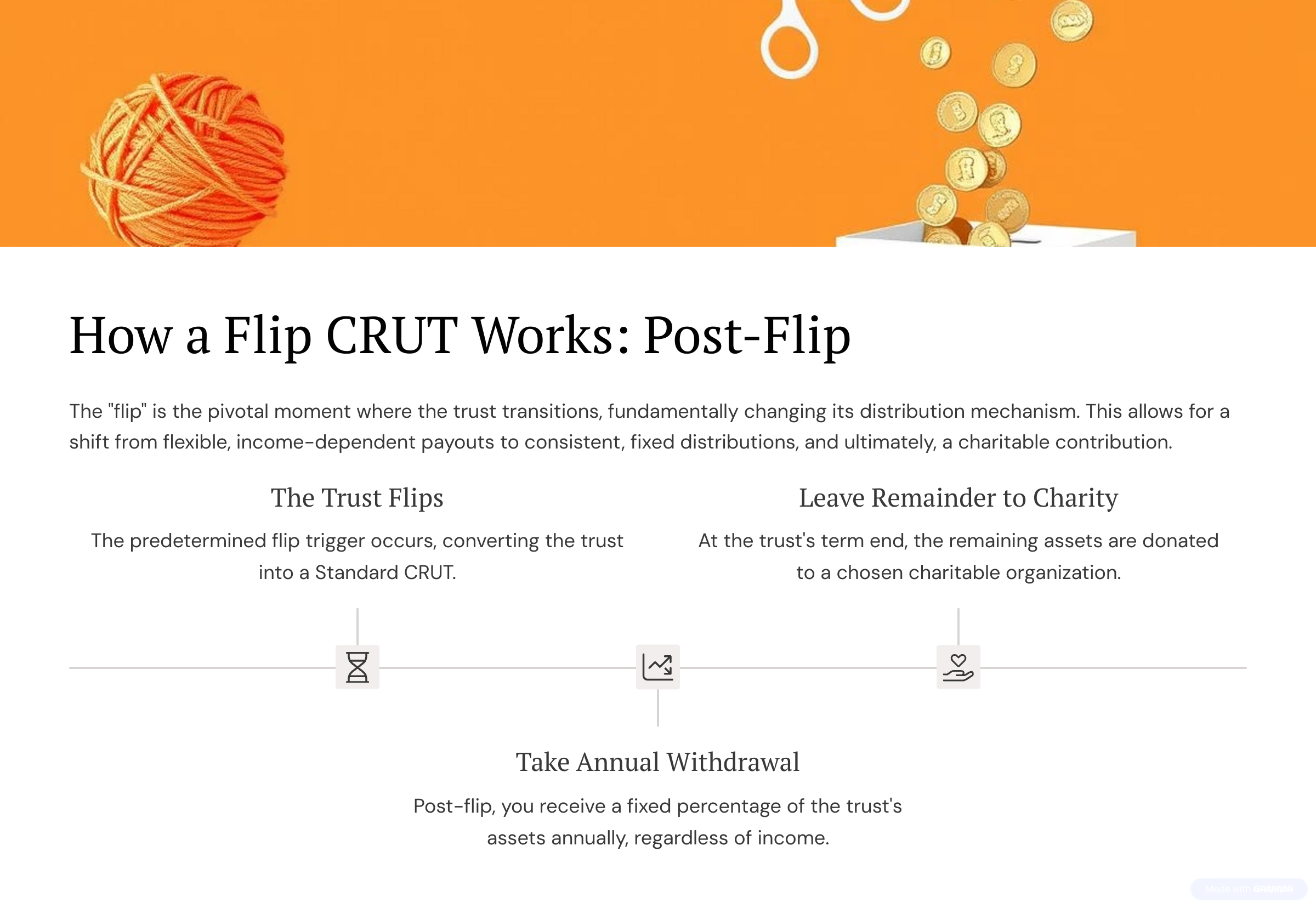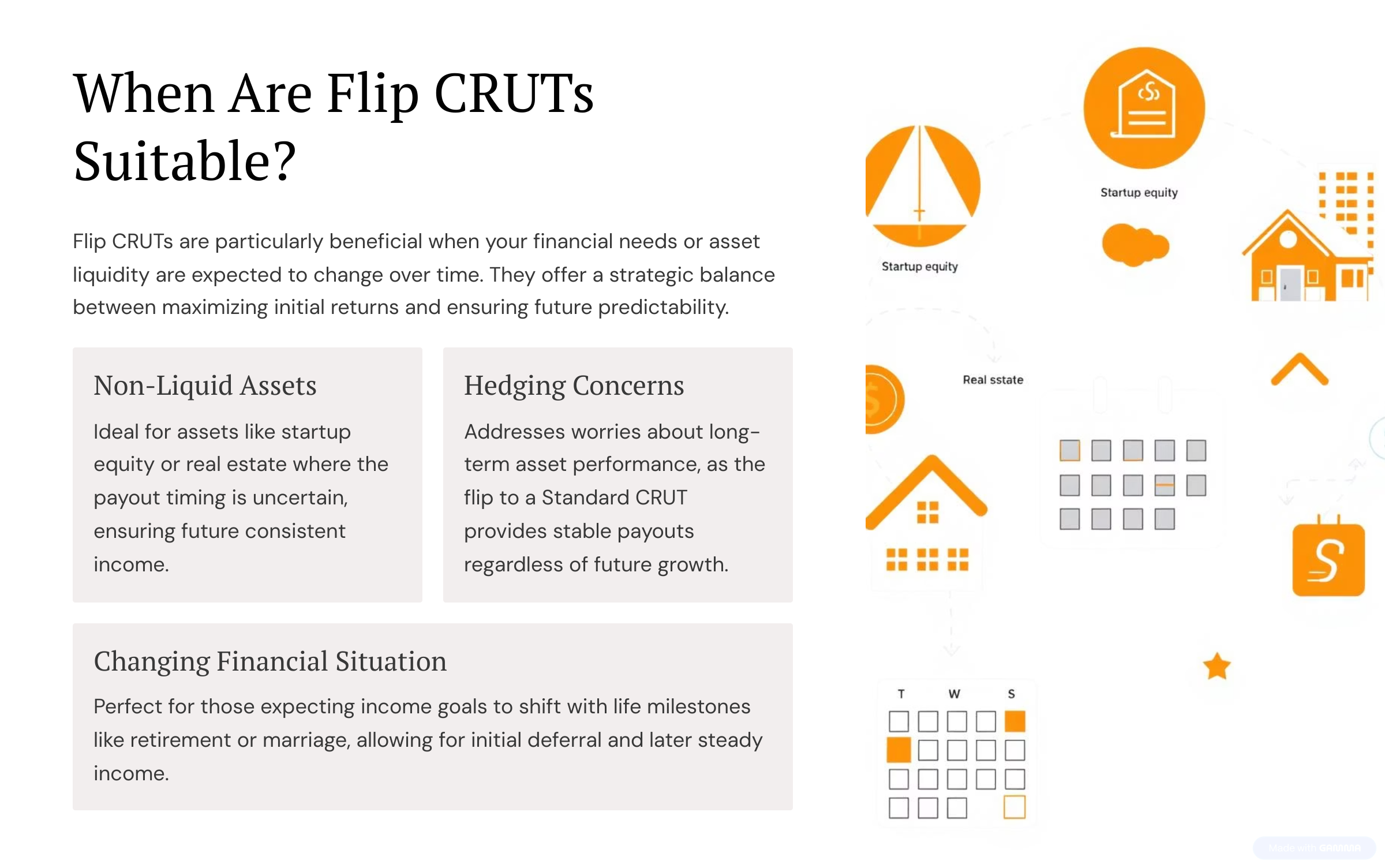A Flip Charitable Remainder Unitrust (CRUT) begins its life as a Net Income Make-Up Charitable Remainder Unitrust (NIMCRUT) and transitions, or "flips," into a Standard CRUT at a specified point in time. This unique structure provides the initial advantage of allowing investors to exercise greater control over their distributions, which is a hallmark feature of NIMCRUTs. Over time, as the trust matures, it shifts to the more predictable and steady distribution model characteristic of Standard CRUTs. This transition is particularly beneficial for individuals who wish to defer distributions while holding non-liquid assets, ultimately leading to a more stable income stream. By offering this flexibility, Flip CRUTs accommodate those who are planning for future financial needs while also managing their current investment strategies.
The operational mechanism of Flip CRUTs is predicated on their ability to change from a NIMCRUT to a Standard CRUT upon the occurrence of a pre-established triggering event. Such events may include the sale of non-marketable assets or the passage of a specific duration, typically a number of years. This feature makes Flip CRUTs particularly advantageous for individuals who hold non-liquid assets that cannot be easily converted into cash for an extended period. When a Standard CRUT is in effect, the trust may be required to liquidate or distribute non-liquid assets to fulfill its distribution obligations. Therefore, Flip CRUTs serve a dual purpose: delaying initial distributions while accommodating a future transition to regular, reliable payouts.
While many of these steps may look familiar to other types of CRUTs, about half the steps are different due to the added dynamic of the flip provision.
- Designate a beneficiary. You designate an income beneficiary — the person who will receive payments from the trust. Most of our users choose to be the income beneficiary themselves and/or name a partner or child.
- Choose a trust type. If you select a Flip CRUT, your trust begins as a NIMCRUT. In the beginning stages, there will effectively be no difference between a Flip CRUT and a NIMCRUT.
- Set your flip trigger. This is the only step unique to a Flip CRUT. The “flip trigger” is a fancy way of describing the factor that dictates when the trust flips to a standard CRUT.
- Transfer assets & get a deduction. You transfer your chosen assets to the trust, and you get an immediate charitable deduction, usually about 10% but can be greater, of the value of the asset you put in.
- Sell assets tax-free. This is the key, and it’s the same no matter the type of Charitable Remainder Trust you choose: You sell your asset, and, in most cases, the trust pays no taxes on that sale, allowing you to grow more money for longer.
- Take your annual withdrawal, or don’t. So you’ve decided you’d like a distribution. What now? The Pre-Flip. The trust has to realize income by selling an asset; otherwise it won’t have the income to meet your withdrawal needs.
- The trust flips. The time has come: The flip trigger you set when you formed the trust has finally occurred. The trust is now effectively a Standard CRUT.
- Take your annual withdrawal. This is the post Flip step. With a standard CRUT, this is a fixed percentage of your trust’s assets every year no matter what.
- Leave the remainder to charity. The remainder —whatever is left in the trust at the end of the trust’s term — is donated to a charitable organization. Recall that this is the reason your money gets to grow tax free in the first place: You get the tax exemption, and in exchange you promise to leave the remainder to another tax-exempt entity — a charity.
Every financial decision made through our guidance is aimed at optimizing what matters most to you. For some individuals, the primary focus is on maximizing returns from their investments. Others prioritize predictability and minimizing risks in their financial portfolios. Additionally, there are those who recognize that their financial needs may evolve over time, requiring a more adaptable investment strategy. The core advantage of a Flip CRUT is its ability to start by maximizing returns through the flexible distribution structure of a NIMCRUT, followed by an eventual transition to the dependable payouts of a Standard CRUT. This adaptability allows investors to align their financial strategies with their changing priorities and goals.
Individuals often consider a Flip CRUT in various specific circumstances that align with their financial objectives and asset holdings. One common scenario involves ownership of non-liquid assets, such as startup equity or real estate. In this case, if the timing of payouts is uncertain and one desires consistent income in the future, a Flip CRUT becomes almost essential. A pure Standard CRUT would impose annual payment requirements that may not be feasible given the situation. Another scenario includes concerns about the long-term performance of an asset or overall portfolio. In such cases, a pure NIMCRUT may not be optimal, as stagnating asset growth would limit withdrawal capabilities. Lastly, significant life events, such as entering retirement, marriage, or welcoming a child, can lead to changing financial circumstances, making the delayed payout structure of a NIMCRUT appealing initially, while the steady income provided by a Standard CRUT may be more suitable later on.
To clarify the distinctions between a Flip CRUT and NIMCRUTs, we will explore common scenarios that highlight how each type of trust operates. Whether you are dealing with illiquid assets, planning for future uncertainties, or seeking flexibility in your charitable trust format, understanding these differences is crucial. Each trust type is designed to address specific financial situations and asset characteristics, allowing for more tailored approaches in wealth management.
Standard CRUTs mandate annual payouts, regardless of the assets held within the trust. This requirement can pose challenges for those with only illiquid assets, as fulfilling the trust's payout obligations might necessitate selling shares at inopportune times or at unfavorable prices. This situation highlights a significant limitation of Standard CRUTs, especially for investors who prefer to maintain their asset holdings. To mitigate this issue, alternative structures must be considered to ensure that both the trust's obligations and the investor's preferences are met.
A NIMCRUT can serve as a viable option at the outset, providing the opportunity to defer withdrawals while simultaneously building a "make-up account" during the years leading up to a liquidity event. This allows investors to withdraw accumulated gains once the asset is sold. However, a critical aspect of NIMCRUTs is their limitation to only distribute realized income, which may result in inconsistent distributions from year to year, potentially complicating financial planning. Therefore, while a NIMCRUT may offer initial advantages, it may not be the ultimate solution for those seeking reliable income.
While a NIMCRUT may provide flexibility initially, it might not fulfill long-term objectives. Investors who appreciate the idea of accumulating a make-up amount over a few years to defer taxes may eventually prefer the consistent annual payouts offered by a Flip CRUT. By selecting a Flip CRUT, individuals can enjoy the benefits of building their make-up provision initially, and once the asset is sold or after a predetermined period, they can transition to a Standard CRUT. This strategic approach ensures that they receive steady distributions, irrespective of the asset’s performance at the time of sale, thereby aligning with their financial goals.
A flip trigger, or triggering event, refers to a specific occurrence or time frame that dictates when a trust transitions from a NIMCRUT to a Standard CRUT. The Internal Revenue Service (IRS) has identified several common triggering events that are pre-approved, allowing for a smooth transition of the trust's structure. These events can vary widely and may include significant milestones that align with the donor's life or financial circumstances.
- On a specific date
- When you sell a previously unmarketable asset or security, such as startup equity, real estate, or collectibles like rare coins
- When you sell your residence
- When you reach a specific age
- When you get married or divorced
- Upon the birth of a child
- Upon the passing of a partner or parent
It is essential to understand that triggering events must not be "under the control of" the donor or any other individual involved. Additionally, these events are typically designed to facilitate the trust's transition to a Standard CRUT when the donor anticipates needing to commence steady payments. In practical terms, this means that while you can define what type of event will prompt the flip, the precise timing of that event cannot usually be dictated or altered once the trust has been established.
